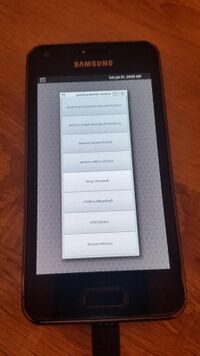Samsung Galaxy S Advance (samsung-janice): Difference between revisions
m clearify, that the port does not run on mainline yet |
|||
| Line 123: | Line 123: | ||
* [https://github.com/Epirex/Samsung_STE_Kernel/tree/marshmallow Epirex's Kernel] | * [https://github.com/Epirex/Samsung_STE_Kernel/tree/marshmallow Epirex's Kernel] | ||
* [https://github.com/Epirex/android_vendor_samsung_u8500 Epirex's vendor files] | * [https://github.com/Epirex/android_vendor_samsung_u8500 Epirex's vendor files] | ||
* [https://git.kernel.org/pub/scm/linux/kernel/git/torvalds/linux.git/tree/arch/arm/boot/dts/ste-ux500-samsung-janice.dts Upstream devicetree] in Torvalds' kernel tree | |||
=== Photos === | === Photos === | ||
Revision as of 15:40, 21 September 2021
| This device is still running on armhf, although the processor supports armv7. If you own it, change it and test it that way. |
| The chipset of device is already supported in the mainline kernel: ST-Ericsson NovaThor U8500 |
 Samsung Galaxy S Advance running Weston demos | |
| Manufacturer | Samsung |
|---|---|
| Name | Galaxy S Advance |
| Codename | samsung-i9070 |
| Released | 2012 |
| Hardware | |
| Chipset | [[ST-Ericsson NovaThor U8500]] |
| CPU | Dual-core 1.0 GHz Cortex-A9 |
| GPU | Mali-400 |
| Display | 480x800 AMOLED |
| Storage | 8/16 GB |
| Memory | 768 MB |
| Architecture | armv7 |
| Software | |
| Original software | Android 2.3.6 on Linux 2.6.35 |
| postmarketOS | |
| Category | testing |
| Pre-built images | no |
| Flashing |
Works |
|---|---|
| USB Networking |
Works |
| Internal storage |
No data |
| SD card |
No data |
| Battery |
Works |
| Screen |
Works |
| Touchscreen |
Works |
| Multimedia | |
| 3D Acceleration |
No data |
| Audio |
No data |
| Camera |
No data |
| Camera Flash |
No data |
| Connectivity | |
| WiFi |
Works |
| Bluetooth |
No data |
| GPS |
No data |
| NFC |
No data |
| Modem | |
| Calls |
No data |
| SMS |
No data |
| Mobile data |
No data |
| Miscellaneous | |
| FDE |
Works |
| USB OTG |
No data |
| HDMI/DP |
No data |
| Sensors | |
| Accelerometer |
No data |
| Magnetometer |
No data |
| Ambient Light |
No data |
| Proximity |
No data |
| Hall Effect |
No data |
| Haptics |
No data |
| Barometer |
No data |
Contributors
- drebrez
What works
- Compiling the kernel
- Flashing with heimdall (see below)
- Booting initramfs
- Network through USB
- SSH
- Weston with touchscreen
- Wifi (Details below and in #138)
Boot process
Unlike most other Android devices, the i9070 can not boot a boot.img (which consists of kernel + initramfs). Instead, the boot.img file is just a regular kernel.
However, it is possible to directly integrate a initramfs into the kernel at kernel compile time (this is totally different from the boot.img approach, if this is unclear to you, please ask in the channel), and this is what the Android ROMs do on the i9070. While it is not a big deal in the Android compilation process, it is a problem for postmarketOS, because we want to be able to build the initramfs independently from the kernel.
The following workaround is currently implemented:
- We flash the real initramfs to the kernel2 partition (this partition usually contains a backup of the stock kernel)
- The initramfs init script built into the kernel checks if the kernel2 partition contains a compressed initramfs, and if it does, it extracts it and passes execution to the real initramfs init script.
- This idea is based on something called "isorec".
Device partitions
The following partitions are used for the postmarketOS:
- Kernel => /dev/mmcblk0p15 (16MB)
- Kernel2 => /dev/mmcblk0p17 (16MB)
Possible partitions for the postmarketOS system image:
- SYSTEM => /dev/mmcblk0p3 (600MB)
- DATAFS => /dev/mmcblk0p5 (2GB)
Flashing with heimdall
In order to flash the kernel and the initramfs using heimdall you simply have to call pmbootstrap flasher flash_kernel
This will write in the partitions specified in the deviceinfo file.
At the moment is not possible to write the system image file (samsung-i9070.img) using heimdall. A temporary solution is to use the TWRP shell to perform a command like this:
dd if=samsung-i9070.img of=/dev/mmcblk0p5
How drebrez made wifi work
- build the kernel module (dhd.ko for the i9070)
- get the vendor files for the Samsung U8500 devices
- load the module using insmod with the firmware_path and nvram_path parameters
insmod dhd.ko firmware_path=/etc/wifi/bcmdhd_sta.bin nvram_path=/etc/wifi/nvram_net.txt
- set a mac address
ifconfig wlan0 hw ether 01:02:03:04:05:06
- bring the interface up
ifconfig wlan0 up
- scan to find out what WiFi networks are detected
iw dev wlan0 scan
- connect to WPA/WPA2 WiFi network
wpa_passphrase wifi_ssid wifi_key >> /etc/wpa_supplicant.conf
- start wpa_supplicant to connect to the network
wpa_supplicant -B -D wext -i wlan0 -c /etc/wpa_supplicant.conf
- verify that you are indeed connected to the SSID
iw wlan0 link
- start udhcpc to get an ip address
udhcpc -b -i wlan0
Links
- Device package
- Kernel package
- Epirex's Kernel
- Epirex's vendor files
- Upstream devicetree in Torvalds' kernel tree
Photos
- Initramfs asking for the password via telnet
- postmarketOS demo menu (XWayland)
- Weston-terminal running in fullscreen mode